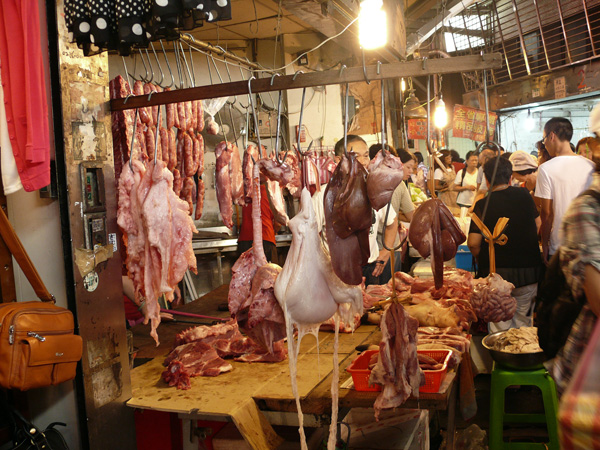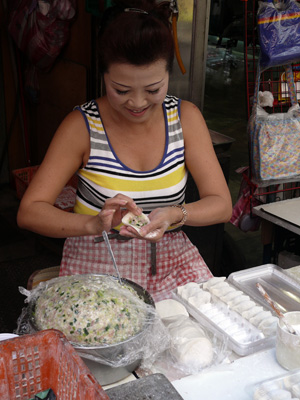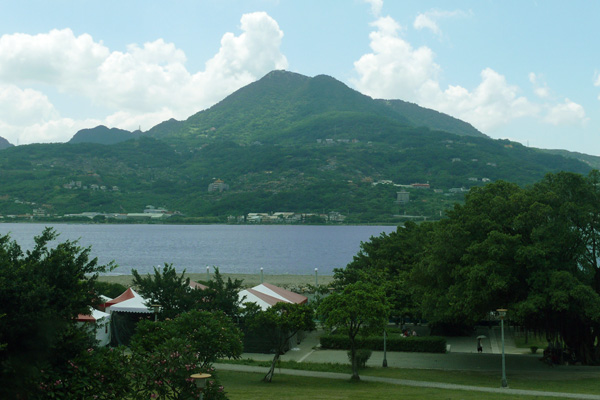TAMSUI, TAIWAN – The concierge at Taipei’s Sherwood Hotel questions my decision to make an early morning trek to this riverside town located at Taiwan’s northern tip.
“September mornings much too hot in Tamsui,” the dutiful concierge tells me. “We Taiwanese call Tamsui the ‘Breath of the Tiger’ because it is so hot there in September – better wait and go there later in the day when the wind cools town.”
But I refuse to heed the woman’s warnings - what do the locals know, anyway? I won’t be swayed from visiting a town where legendary Canadian missionary George Leslie Mackay left such a lasting legacy. So I hop on Taipei’s excellent MRT (a subway/light rail transit combo that costs just pennies to ride) and make the hour-long journey to this city where the mighty Tamsui River and the East China Sea meet.
As I step from Tamsui rail station, I’m pushed back by the “Breath of the Tiger.”
A searing heat, the likes of which I’ve never before experienced, literally takes my breath away.
And it’s not yet 10 a.m.
Nothing can prepare you for the heat that engulfs this robust fishing town where Presbyterian missionary MacKay first arrived in 1872 and began setting up Taiwan’s first schools, churches and hospitals.
And while the man from Oxford, Ont., is relatively unknown in his native land, here the long bearded Mackay remains a local legend - streets are named after him and a larger than life statue of the man stands in a park that carries his name.
There’s so much named “Mackay” here that after a while you wonder if Tamsui really means “Mackayville” in Taiwanese.
Being a Canadian tourist in Tamsui (the town is also known by its Chinese name Danshui) also affords you special treatment. Once people see the Maple Leaf pin on my shirt, they approach and ask if they can help direct me to the places the revered Canadian once lived?
One woman suggests it’s much too hot to stay on the main streets and advises me to visit “Market Street where it’s much cooler in the morning.”
The hot, heavy air hanging over the narrow street that makes up the city’s traditional market doesn’t feel any cooler than what I experienced outside the rail station. And the unrefrigerated meat and fish sitting in the stifling heat is starting to omit a most unpleasant odor.


Left: Meat and poultry hands in the stifling heat. Right: A vendor makes some dumplings that locals just love.
It’s time to exit Market Street.
As I enter one of the town’s main streets, I find myself surrounded by a sea of umbrellas. The women of Tamsui guard against the baking sun by carrying open umbrellas on this cloudless day. Those riding one of the annoying little scooters that dominate the streets here have their arms covered with long-sleeved garments and visors protect their face – Chinese skin, like mine, bakes easily.
A long lineup attracts me to an ice cream kiosk on Gongming St. – it’s another pedestrian thoroughfare dominated by restaurants and souvenir shops.The vendor doesn’t get the cone filled before the ice cream starts to melt. Not to worry – the cones here come with a built in lip to capture the creamy goodness. A few brave cyclists peddle along the paths built along the riverbank and which lead to Zhongzheng Rd (a.k.a. Old Street) where Mackay’s statue stands. This is the area where he first lived when he arrived in Tamsui.
Also close by is Tamsui Church, a larger model of the first church Mackay built on this very site when he came to the city. The present structure is far grander than the original and was actually designed by Mackay’s son, George William Mackay after his father’s death in 1901.
Next to the handsome church is Mackay Hospital, built in 1879. Mackay performed medical treatments in rented homes before the hospital was built – Mackay designed the hospital himself and incorporated Western-style windows into the traditional Chinese design. The hospital has been turned into a museum and visitors can see the original iron beds and medicine bottles Mackay used in that era. Taipei’s main downtown hospital is named after the Canadian - Mackay Memorial Hospital.
I follow Mackay St. up to an area known as Missionary Road (Zhenli St.). Mackay and his ancestors had the good sense to plant lots of trees along the route and they’ve grown to monster size - providing me with plenty of cooling shade.
Missionary Road features a group of buildings very much associated with the Mackay legacy - Oxford College, the Mackay family residence, and two structures where unmarried female (The Residence of Misses) and male (The Residence of Reverends) once resided.
In addition to preaching, Mackay also taught his followers in outdoor classrooms when he first arrived. In 1882, thanks to donations sent from people in Mackay’s Canadian birthplace, Oxford County, Ont., a permanent school was built and named in honour of Mackay’s hometown. Now a combination of museums, Oxford College displays an extensive collection of photos, documents and items related to that early period.
The Mackay residence is a striking white structure with an imposing wrap-around porch that looks much grandeur than homes normally associated with missionary preachers.The home where Mackay married his Taiwanese bride, raised his children and eventually passed away in was completed in 1875. Here Mackay held prayer meetings and entertained guests. The house, which is surrounded by a glorious collection of flora and fauna, also serves as a museum and showcases many family artifacts.
The “Misses” and “Reverends” residences are two large red bricked buildings that were designed by another Canadian missionary, William Gauld - he also designed the city’s renowned Women’s School and is buried in Tamsui’s Foreign Cemetery.
The Mackay Family Cemetery is separated from the Foreign Cemetery by a stone wall. Mackay, who succumbed to throat cancer in 1901, is buried under an obelisk tombstone, which is surrounded by the graves of his wife, children and some of his students.
Tamsui started making history long before Mackay arrived. Because of its strategic location, the Spanish, who dubbed Taiwan “Formosa”, built a fortress (Fort San Domingo) here in 1628. That fortress disappeared long ago but the fort the Dutch built in 1646 (Fort Antonio) has withstood the test of time and can be visited. A fort built by a Qing Dynasty emperor during the Sino-French War and hidden in a forest, is also part of a tour of Tamsui.
This city also has its share of impressive temples – the 18th century Fuyou Temple, as well as two 19th century worship halls - one known as Longshan Temple (one of five major Longshan temples in Taiwan) and the other Yinshan Temple, built by the Hakka Chinese in 1822. The Qingshui Zushi temple built in 1937 may not be as old as the others but it’s no less impressive.
By the time I reach Fisherman’s Wharf, I’m in need of refreshment and stop for a cold bottle of Taiwan beer – lighter than most Asian beers but thirst quenching on this hot day. That went down so well, I order another and watch tourists pile onto a ferry headed for an out island known as Bali – a much lesser version of its Indonesian counterpart.

Above: The volcanic scenery surrounding the area is breathtaking.
As the ferry pulls away, a light breeze begins to blow in off the water – it’s mid afternoon; the perfect time to visit Tamsui – just like the concierge advised.
Information
- Best way to get to Tamsui is by MRT from downtown Taipei – take the line headed for Danshui station. The MRT ride costs less than $3 Cdn. and takes about an hour.
- Tamsui was originally settled by the Taiwanese aboriginal people, the Austronesians.
- Chinese started arriving in Tamsui around 1684 when the city became part of the Qing Dynasty.
- Tamsui was once the largest and biggest harbor in Taiwan.
- Tamsui’s main industry today is tourism.
About the Author
Marc Atchison is a veteran journalist and a seasoned traveller with more than 20 years of travel writing experience. As the former Travel Editor of the Toronto Star, Canada's largest newspaper, and now Editor-in-Chief and Senior Writer for TraveLife magazine (Canada) and travelife.ca, Marc has been to over 100 countries in the world. Japan is one of his favorite destinations and he's been there on numerous occasions.